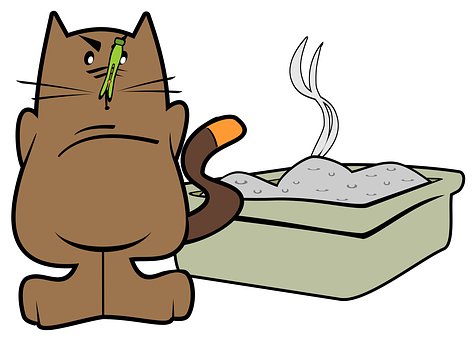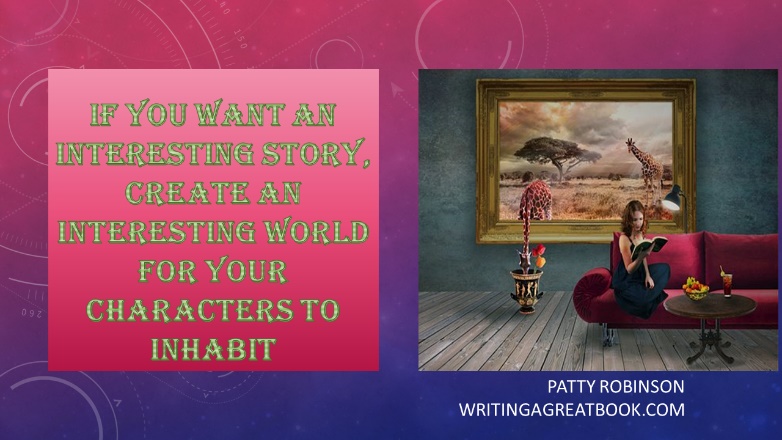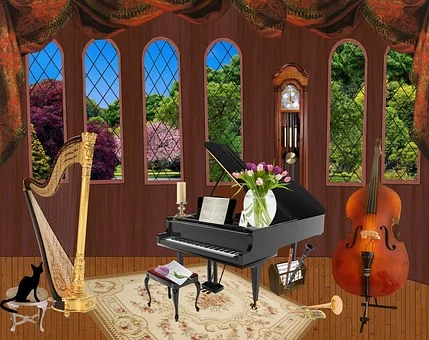
Show your characters by creating a setting that reveals their personality, status, interests and mood.
Have you ever considered how to use things in your setting to show your characters?
This may sound crazy, but hang in there with me.
On the other hand, have you ever caught your self labeling your characters. You know, he is smart, she is funny, he is rich, she is beautiful. In other words, “telling” your readers about your characters instead of showing.
There has got to be a better way.
We have found one secrete is to create settings that show your characters. Then you don’t have to tell your reader about your characters.
Fortunately, there are some tricks we can show you that will help you show your characters using your setting. Would you agree, learning the art of ‘showing is crucial to great storytelling?
Yes, you bet it is.
‘Showing’ is the magic trick that breathes life and energy into your characters.
If you haven’t learned the skill of showing yet, dig in. We have 8 tricks to help you.
We have created a one page cheat sheet to remind us how to create a fabulous setting that reveals our characters.
GRAB IT NOW!

Well let’s get started. These tricks may change The Way Write.
Show Your Character’s Personality Using Your Setting
Have you ever wished for a simple way to show personality? Well here it is in a quick and easy formula to show your characters using your setting.
First decide what personality your character has. We list four basic types. Then use this section to show that personality with your setting.
Show Your Characters Who are Fun-Loving
A fun-loving personality makes it easy to show your character using your setting This personality admires beautiful things. So, add things to your setting for them to admire, Include flowers and colors., sunsets and music. Anything they can see, touch, smell, or hear.
Fun-loving characters use delightfully positive dialogue. Their dialogue is full of praise for their surroundings. They stop to smell the roses and want to touch everything. This type of character sees the beauty in the world around them. Their dialogue will include comments about loveliness, wonderment, and awe.
They are curious about both things and people. But one fascinating thing is; they will pick up objects, inspect them and quickly put them back, no longer interested.
Fun loving personalities notice the sensory elements of their surroundings.
They love music and dancing. Colors are important to them. Because of this it is easy to let your character notice colors in your setting.
They are often disorganized. Their living space will be messy. They are simply too busy having fun, to clean up.
If you want your character to be fun loving, dress them in bright colors, yellow, orange, or red. Add jewelry. This personality wants to be noticed.
This personality notices the dimensions of things (the height or weight). The size and shape of objects will fascinate them. They are specific. (The hallway is 30 feet long. Or She could not have weighed more than 110 pounds) Their dialogue may include criticism of their surroundings. Keep in mind, they are curious. They will examine things in your setting, to see how they work, not to admire them like fun loving personalities.
They have a scientific way of thinking and speaking
Their living space is neat and uncluttered. Everything perfectly in its place. They may become anxious if things are not perfect.
Analyzers love charts, graphs and numbers. Include these in your setting to show your character is analytical. They enjoy art music, and poetry. Analyzers like their world to be systematic. So, let your analytical character notice the small details, in your setting, details, others may miss.
Dress the analyzer in brown, gray, or blue. They don’t like to be noticed.
They are watchers and observers.
This personality is very observant. They especially look for things that might be useful to manipulate others. Because of this they will notice things like awards and trophies. With this intention, power-broker will sweep the room with his/her eyes and see everything all at once.
They make quick (generally accurate) judgments.
Another point, they expect others to maintain their surroundings in good order. This personality becomes very critical, if things are out of place, or if they can’t find what they want, quickly.
The power-broker likes bold colors and fast vehicles. (Red sports cars) They wear black, red, gold, or purple. In the hope of appearing taller they might wear boots or very high heels. They fill their world with good quality possessions.
Only the best is good enough for a power-broker.
If you want your character to exude power, include things in your setting that demonstrate this personality.
Show Your Character Has A Peaceful Personality Using Your Setting
A peaceful personality won’t notice much about the setting. They will be indifferent to both people and things. Their living space will often be messy, simply because they don’t want to be bothered.
In some ways this subdued personality is difficult to write. It is often more about what is not said that creates this personality in fiction.
A peaceful personality enjoys quietly watching from the background.
They dress in plain, dull colors. They often speak in unemotional, practical terms. Other characters may consider them shy. They rarely speak first in a conversation.
The things they own will be plain, simple, and functional.
Before you leave this post take the opportunity to download an extensive list of websites categorized by the type of setting you are trying to create:
Show Your Characters by Using All Your Characters Senses
Using All Your Characters Senses
Create a setting that will evoke all your character’s senses. Sensory detail have the additional advantage of creating emotional responses from your reader.
In order to make this simpler we have created a checklist of all the things you need to include in your setting, If you use this graph for every scene you write, you will be amazed how much better your scenes will become.
One trick is, as you edit, see what sensory descriptions can be added. Use our check list to be sure you have a setting that shows your characters
Put yourself in your character’s place. What do they see, hear, smell, taste, and touch? How can you add those details? Adding sensory details is part of the fun of editing. It is also an intriguing challenge.
What your character sees is important. But let me stress the other senses which are just as essential.
Smells especially can evoke memories. Different aromas trigger specific feelings.
- The pungent smell of fresh mowed grass

- Sweet scented meadow
- The stench of a rotting corpse
- The aroma of fresh baked bread
In addition, touch may evoke an emotional response.
- The silkiness of a bunny’s fur

- A soft breeze on her face
- The roughness of rocks on bare feet
- Rain pelting his cheeks
That’s not all, sounds can affect your characters in many ways.
- The whistle of a falling bomb is frightening

- A clicking clock may be annoying
- A chirping chickadee might delight your character
- The throbbing beat makes Jane want to dance
Taste can show your characters too.
John and I think taste is the most difficult element to incorporate into our settings. But it can show your character in a very effective way.
What do they like to eat? What do they refuse to eat? Why? How does your character’s background effect their feelings about food?
- The juices dripped from the corner of Julie’s mouth as she bit into the bright red Apple.
- His mouth burned from the fiery jalapeno peppers.
- His mother always cooked home made raviolis when he came home from a trip.
See our post: 493 Ways to Describe Taste to Inspire Great Writing
Each of the senses you include, adds to the whole picture and gives your reader insights into your characters. 
What Your Character Owns Can Show Status.
Do you want to know another trick? This trick is not so obvious. But it is one of the easiest ways to show your character’s situation..
What would you find in your character’s wallet or purse? Have you ever considered rummaging around in your fictional character’s top draw? What would you find?
Each item a character owns shows your reader a little more about that character.
- Does he own the most up to date electronic gadgets?
- Is she constantly checking off a list?
Telling simply supplies the reader with information. Showing paints, a more vivid picture of your character, allowing your reader to better visualize them.
- Instead of saying he’s rich. Mention he’s wearing a Rolex watch or diamond stick pin..
- As An Alternative to saying she loves to travel, let her show photos of exotic places in her wallet or on the walls of her apartment.
- As a way of saying she’s fearful have her remove a container of mace from her purse or maybe even a small gun.
- Another way to show he’s athletic is to have him carry a gym bag.
- Instead of saying she has children let her take something sticky with peanut butter out of her purse.
Can you see how your setting can actually show your character to your reader? This is one of many little hidden secrets that will make you a better writer. And we all want to become better writers.
Check out: princeton.edu/whats-in-your-wallet for an interesting project.
And. whats-in-your-characters-wallet-by-linnea-sinclair/
Show Your Character’s Mood.
How does the setting affect your character’s mood?
Here’s the best part, every scene presents you with the unique opportunity to demonstrate your character’s emotional responses to your setting.
Allow your audience to feel your setting from the character’s point of view.
It is fascinating to me, but everyone reacts to light and dark. Sunny weather makes us feel good. Darkness is ominous. Use this to help your reader feel your character’s emotions and be pulled into the scene.
Dark settings create a darker mood of sadness, fear, or impending danger.
- Dark shadows snaked across his path
- The rumbling echo of thunder sent chills down my spine.
- Clouds a mixture of black and purple smeared the sky
- Lighting forked across the sky followed by growls of thunder
Similarly, lighter, sunny settings brings hope, happiness, or maybe even love.
- Leaves dancing in the sunlight.
- The moon’s glow made a silver path across the water.
- The rich yellows of sunrise soared into the sky.
- The sun bathed the land in a thick honey glow.
Can you feel the mood?
Do you get the idea? You can use your setting to manipulate your character’s mood (and hopefully your reader’s mood). Maybe even to suggest an upcoming event.
Readers don’t want to be told your character is happy or sad, they want to feel it.
For more Ideas on creating mood with your setting See:
Creating the Mood of a Story from Now Novel
Before you leave take the opportunity to download an extensive list of websites categorized by the type of setting you are trying to create:
The Well-Dressed Setting
One purpose of the well-dressed setting is to provide your readers with clues about your characters. You want to include things in the background of your story to show the nature of your characters.
Think about features you can add to your setting that will give your readers insights about your characters.
Showing is a skill that can be learned.
Can you see yourself using these ideas?
Are you ready to do this? That’s all that really matters. Trust me, you’ll be glad to add these tricks to your writing.
You can give your audience hints about your character’s personality.
Or maybe you can create a fictional world that illustrates your character’s disposition and background.
We hope our article will stimulate your thinking. You now have the tools to unleash the characters you imagine.
With practice you can master the art of showing.
We hope these tricks will inspire you to add details to your setting. Details which will help your readers understand your characters better. Don’t forget to Grab your bonus:
Happy Writing
John & Patty
@Writingagreatbook.com 2020
Tell us how you have used your setting to describe a character?
We invite your comments.
Try our check list. Let us know if it has been helpful.
If you enjoyed this post, please share it with your friends.












